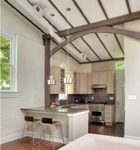
C3D incorporated much of the original church’s architecture when conceiving The Residences at St. Monica’s, including its timber beams and trusses.
The limits of a budget can hinder good design, so after spending years working in the building and architectural sector—where projects are primarily economically driven—Grant Epstein sought a way to place design and financing on the same footing. After earning an MBA from Georgetown University, Epstein wrote a business plan for a company that would to exactly that, and the plan became Community Three Development, LLC (C3D). Located in Washington, DC, the firm specializes in revitalization and restoration of underutilized real estate, and for every project it focuses on three core concepts: value, innovation, and sustainability.
“We seek to give old buildings new life by repurposing them with the latest innovations, sustainable features—and making decisions that add value,” says Epstein, who now serves as president. And recently, for the Residences at St. Monica’s, the firm married adaptive reuse and aesthetic preservation in a way that reuses more than just the exterior building envelope to maintain both budget and character, just as Epstein originally intended.
The original St. Monica’s Episcopal Church was built in 1908 to resemble the Chapel of the Nativity of Jesus Christ in Bethlehem, Israel. In 1930 there was an addition and gathering hall that increased the church size by 4,000 square feet. But in 2009, St. Monica’s parish merged with St. James’s Episcopal Church, and St. Monica’s church building was deconsecrated, a necessary step for its purchase and subsequent repurposing.

From the outside, the former church building housing the new residences appears virtually unchanged.
“With historic preservation, the challenge is to respect the heritage of a building, preserve the character, and embrace what the site used to be,” Epstein says. “It is definitely an opportunity to be innovative.” The challenge C3D faced with St. Monica’s was to maintain the look of the church and minimize impact on the exterior. But at the same time, as residences, the nine units on the inside would need to meet code, be energy-efficient, and reuse as many of the existing materials as possible.
One major challenge was working with a single-story civic structure, which was not originally intended to support multistory residential loads. The church also was built without insulation and originally had single-pane windows, so C3D determined a comprehensive and targeted thermal envelope would be necessary. While installing this envelope, the firm had to maintain key structural elements and materials, and because C3D was faced with aging walls that weren’t plumb, the firm needed to make safe, secure connections between old and new.
From the outside, the structure has been preserved and still looks like the original church. The 100-year-old stained glass windows are protected by custom storm windows that also add an additional layer of thermal protection to the units. “Giving original features a sensitive modern retrofit, we keep the elements and preserve the heritage of the site for another 100 years,” Epstein says.

For ultimate efficiency, the structure is insulated by a rigorous building envelope. A more apparent amenity: residents also have access to a private, landscaped outdoor space.
No two residences inside are laid out the same, and each one takes advantage of the original architectural features of the church. The timber beams and trusses were restored and reused in the high ceilings and walls of the units. And in one space the altar was repurposed as a kitchen island and is positioned in its original location. The nine unique homes each also have access to a private, landscaped outdoor space and to St. Monica’s park.
In addition to sealing the building envelope and installing insulation and multipane windows, C3D modernized each residence with high-efficiency heating and cooling systems, custom wiring, and energy-efficient stainless-steel appliances. The finished spaces are now available to buyers, who will enjoy additional features such as hardwood floors, recessed lighting, and tiled baths and kitchens.
“Adaptive reuse is economical and sustainable while also allowing for a design solution that respects the history of the building and the site,” Epstein says. While the practice tends to take more coordination and planning, for C3D the economic savings is smart. Materials not being reused in a project are carefully removed and then donated to reclamation yards, making the construction process far more conscious. “There is a delicate balance between preservation economics and design,” Epstein says. “We strive to manage all the competing forces in complex projects such as these. From beginning to end, it has really been our driving purpose.”

